The card uses extra-conductive aluminum, improving the housing's heat dissipation. With lowered temperature, the card can survive the hottest climates. Thanks to the external magnetized antenna base, the 2 external antennas are more adjustable, so you can always find the best signal reception quality.
The blue activity light is a little annoying.
With its stylish bodywork, durable construction, consistent performance, and feature-rich approach, the ASUS PCE-AC56 goes beyond the spec, providing improved signal transmission, extending the WiFi range, and eliminating dead spots.
PCI Express (single slot)
2 external antennas, external magnetized antenna base
IEEE 802.11b/g/n/ac
1300 Mbps (2.4 GHz - 400 Mbps + 5 GHz - 867 Mbps)
WiFi Protected Access® (WEP/WPA/WPA2—PSK)
Broadcom® TurboQAM™ technology, Specially designed heatsink
2 years
The OFDMA (orthogonal frequency-division multiple access) channel access method keeps the input lag around 8 ms, reducing the latency ~twofold. The 160 MHz-wide channel will ensure a stable connection with 5G devices even inside dense indoor areas where the signal's usually spotty.
The antennas are massive, so they might limit access to neighboring ports on the motherboard.
While its cutting-edge security is impressive, the construction is tough and durable, and the latest Bluetooth module integrated into the device is an ingenious move, what sets the TP-Link Archer TX50E apart from the pack is its WiFi 6 support, enabling ultra-low latency and uninterrupted connectivity.
PCI Express (single slot)
2 external antennas
IEEE 802.11b/g/n/ac/ax, Bluetooth 5.0
3000 Mbps (2.4 GHz - 574 Mbps + 5 GHz - 2402 Mbps)
WiFi Protected Access® (WEP/WPA/WPA2—PSK/WPA3)
Gold plating, Customized heat sink, Bluetooth connecting cable included
2 years
Aside from standard brackets, the card comes supplied with low-profile brackets, so you'll be able to install it in a mini-tower case as well. The antennas are quite short and pretty thin, which means you won't be blocking neighboring ports. Also, they're detachable.
The heatsink is pretty bulky.
The TP-Link Archer T4E is what everyday users will benefit from the most. In some ways, the two cards the same. Using beamforming, this card is able to focus the wireless signal toward select devices, boosting its range and making sure that the connection remains stable.
PCI Express (single slot)
2 external antennas
IEEE 802.11b/g/n/ac
1200 Mbps (2.4 GHz - 300 Mbps + 5 GHz - 867 Mbps)
WiFi Protected Access® (WEP/WPA/WPA2—PSK)
Customized heat sink
2 years
The MU-MIMO technology supports multiple outputs, enabling more data to be transferred at once. Using this tech, the card can communicate with multiple electronics simultaneously, so you can connect, disconnect, and share the network between them without delay.
The Bluetooth range is limited.
Because the brand is not quite as recognizable as TP-Link or ASUS, with Ubit AX200, you're offered the same specs and tech that the previous companies' high-end models are offering without paying the same price that you would pay with these models.
PCI Express (single slot)
2 external antennas
IEEE 802.11b/g/n/ac/ax, Bluetooth 5.1
3000 Mbps (2.4 GHz - 574 Mbps + 5 GHz - 2402 Mbps)
WiFi Protected Access® (WEP/WPA/WPA2—PSK/WPA3)
Bluetooth connecting cable included
Amazon's 30-day return policy
The target wake time protocol, minimizing contention between clients, will make sure that battery-powered devices that are used on an infrequent basis can communicate without interference. The Bluetooth 5.1 module will let you pinpoint the location of the connected device.
The model suffers from occasional signal drops.
Despite coming at an affordable price and being especially compact, the OKN AX200 is just as capable as its more expensive name-brand contemporaries. With this device, you can stream 8K content, share large files, and game at the same time knowing that the connection can handle it.
PCI Express (single slot)
2 external antennas
IEEE 802.11b/g/n/ac/ax, Bluetooth 5.1
3000 Mbps (2.4 GHz - 574 Mbps + 5 GHz - 2402 Mbps)
WiFi Protected Access® (WEP/WPA/WPA2—PSK/WPA3)
Bluetooth connecting cable included
Amazon's 30-day return policy
This site is a free online resource that strives to offer helpful content and comparison features to its visitors. Please be advised that the operator of this site accepts advertising compensation from certain companies that appear on the site, and such compensation impacts the location and order in which the companies (and/or their products) are presented, and in some cases may also impact the scoring that is assigned to them. The scoring that appears on this site is determined by the site operator in its sole discretion, and should NOT be relied upon for accuracy purposes. In fact, Company/product listings on this page DO NOT imply endorsement by the site operator. Except as expressly set forth in our Terms of Use, all representations and warranties regarding the information presented on this page are disclaimed. The information which appears on this site is subject to change at any time. More info
ASUS PCE-AC56
ASUS AiRadar Technology
The ASUS PCE-AC56 is fast and feature-rich. Before that though, this is one fancy devil, rocking the same glossy red diamond-plate texture that the company's more expensive electronics are usually sporting. Of course, as much as we can appreciate this device being more attractive than its competition, you insert these wireless cards into motherboards and hide them from plain sight anyway, so appearance matters the least here.
It is a good thing, then, that appearance is not the only thing this device is bringing to the table, not even close. No, that would be the ASUS AiRadar tech. Using the beamforming approach, high power amplification, and the company's patented RF fine-tuning, this technology strengthens the signal, ensuring extended coverage, dynamic data speed increases, as well as enhanced stability.
When you remove this intelligent technology from the equation, this model also introduces the Broadcom® TurboQAM™ tech. With this one, the card can super-charge the 2.4 GHz band, stretching its performance from 300 Mbps to 400 Mbps. Still, this technology would not be quite as effective without the external magnetized antenna base that this device adds to the 2 standard external antennas. Owing to this magnetized base, the 2 antennas can be adjusted pretty much however you please, meaning that you can always secure the best signal reception quality that's possible with your setup.
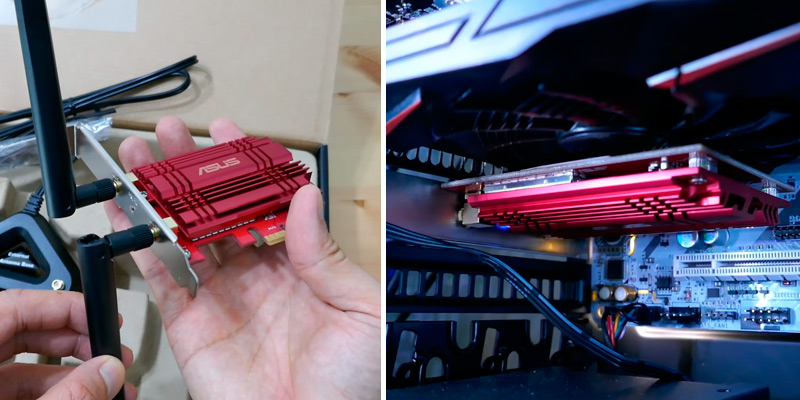
Stylish Bodywork
Back to the model's appearance though (or, to be more precise, its design), the stylish bodywork hides the heatsink that's made from highly-conductive aluminum, removing heat from the chipset and ensuring improved stability to guarantee non-stop use. Lowering its temperature, the housing makes the card more stable, even during cold winters or hot summers.
Turning 180 degrees, the device's signal-boosting high-gain design gives the model improved signal transmission, extending the wireless network range as well as its coverage by ~150% (when you compare the card with generic client devices). With this extended coverage, the card minimizes dead spots, ensuring not just fast but also uninterrupted high-data endeavors like HD streaming or online gaming.
Some might find the blue activity light a little annoying but, again, most people will not even notice it. So, provided you want to make sure that you can always rely on the signal being fast and consistent anywhere throughout the house, go with the ASUS PCE-AC56.

Additional Info
| Last updated price | $54.99 |
| Stock | In stock |
| ASIN | B00JNA337K |
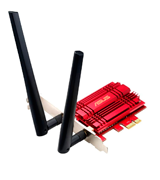
TP-LINK Archer TX50E
WiFi 6
The TP-Link Archer TX50E is a force to be reckoned with. While we're referring to the card's performance first and foremost, we're also referring to its size, which is the device's biggest weakness. To be more accurate, the card is fine, but the antennas are huge, sometimes limiting access to the neighboring ports on the motherboard. Nevertheless, despite its heft, this device is an attractive beast. For starters, between the company's staple MU-MIMO tech and the new OFDMA (orthogonal frequency-division multiple access) method, the model reduces latency almost twofold. With this card, the input lag usually hovers around 8 milliseconds tops, enabling ultra-responsive online gaming or an immersive VR experience on the busiest networks.
Now that we've breached the VR subject, this device uses WiFi 6, the next WiFi generation, bringing to the table solutions like 1024-QAM and 160 MHz bandwidth. In layman's terms, while the 1024-quadrature modulation scheme boosts the connected devices' throughput capabilities, the 160 MHz-wide channel ensures the fastest WiFi yet, giving you a multi-gigabit low-latency connection. With this connection, you can work with 5G devices indoors where wave signals are usually spotty. Even simplified, these technologies sound a little complicated, but the gist here is this - owing to these technologies, even the most bandwidth-intensive applications like VR that demand the highest speeds will be covered.

Gold-Plated Contractors
Sometimes, the best PCIe wireless cards for gaming separate themselves from the middling competition with sophisticated techs, like the technologies that we've highlighted and described above. Sometimes, they also take less sophisticated measures. There's nothing necessarily sophisticated about adding a Bluetooth 5.0 module to the card but the move is quite ingenious nonetheless. With this module, the card lets you connect every Bluetooth-enabled device (game controllers, headphones, keyboards, etc) to the computer without wires or without using Bluetooth USB adapters. Plus, this is BT 5.0 we're talking about, meaning that the connection will be fast and the range will be vast.
Last but not least, the card comes with both standard and low-profile brackets, with the second accommodating mini-tower computer cases. Also, every contractor on this device is gold-plated, preventing oxidation.
Bottom line, the TP-Link Archer TX50E offers WiFi 6, BT 5.0, and improved longevity, so we can only wish less capable WiFi adapters good luck competing with this one.

Additional Info
| Last updated price | $44.99 |
| Stock | In stock |
| ASIN | B089FCX3C3 |

TP-LINK Archer T4E
Improved Thermal Energy Dissipation
The TP-Link Archer T4E is 50% less expensive than its step-up relative that we've discussed above, so the card is not quite as impressive, which is understandable considering the price difference. Plus, while WiFi 6 and an integrated Bluetooth module are great, most people already have the means to establish a Bluetooth connection with the PC and will not benefit from WiFi 6 quite yet.
Of course, the card has its advantages as well, but also its disadvantages. Even though the plate is pretty slim and so are the contractors, the heatsink is relatively bulky, so this device will occupy a little more space than you would initially expect. Still, because the antennas are short and thin, you won't be blocking neighboring ports, so the model's somewhat increased size will not inconvenience you. What's more, these antennas are detachable, meaning that you can always remove them when the connection range is not an issue, freeing up space inside the case.
Also, the heatsink's enlarged footprint is not wasted here. No, made from heavy-gauge aluminum alloy, the 'sink is great at dissipating thermal energy, improving the card's stability. Moreover, working with a lowered average temperature, its lifespan is also increased.
What's not increased is the model's installation requirements. Plug the device into the computer's existing PCI-E port, and follow the drop-dead simple software installation on the provided CD. That said, since more and more computers come without CD/DVD-ROMs, you can always download the software online.

Protected from Hackers
In some ways, the two cards are the same. They both rely upon the beamforming tech to focus the WiFi signal toward connected devices, boosting the network's range and stabilizing the connection. They're both compatible with Windows 10 and previous versions (even including XP).
Not unlike its less affordable stablemate, the Archer T4E is shipped with standard as well as low-profile brackets, fitting mid-tower and mini-tower cases alike. Following the playbook that's deployed across most PCIe wireless cards for gaming, this model employs WPA3, the latest network security protocol that offers safe and individualized password encryption, protecting the network from wireless intrusion and ensuring that the connection is 100% secure.
Long story short, the TP-Link Archer T4E will fit people who have only a few wireless devices at home and these are not necessarily high-end devices that require the latest wireless standards/protocols.
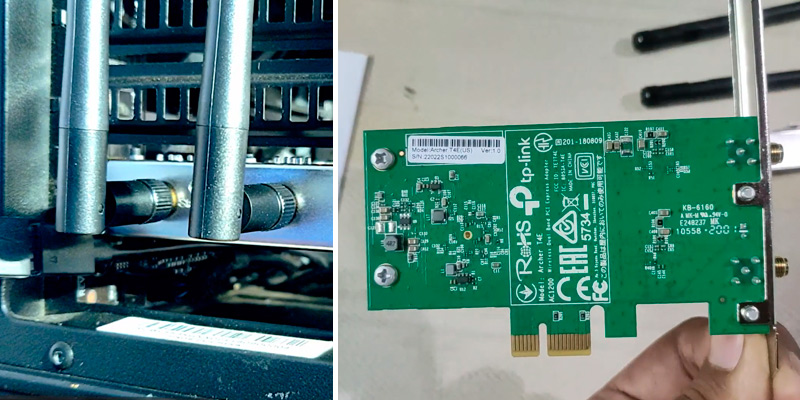
Additional Info
| Last updated price | $29.99 |
| Stock | In stock |
| ASIN | B07NFMSGGR |
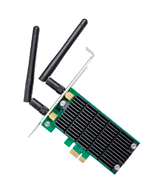
Ubit AX200
Tussling with High-End Cards
When wireless networking is at stake, people usually stick with tried and tested brands like TP-Link or recognizable names like ASUS. They seldom trust names like Ubit. Truth be told, they're usually right. This time, however, we'll try to convince these people otherwise though. As skeptical as we were initially, the Ubit AX200 proved an excellent device that can trade blows with more expensive cards without suffering critical injuries. To be a little more precise, this model offers pretty much the same specs that flagship PCIe wireless cards are offering except that this one seats at the mid-price table.
First things first, this device supports WiFi 6. As always, supporting WiFi 6 means also supporting the OFDMA channel access method, the 1024-QAM modulation scheme, and the 160 MHz bandwidth. With these, the card minimizes input latency, so you can put everything at stake online without worrying that the connection will fail you when you need it most. The 160 MHz-wide channel will even enable VR gaming on busy networks. Plus, the same channel will support 5G devices indoors, including dense spaces.
Apart from the solutions that come with WiFi 6, this card also employs MU-MIMO, communicating with multiple devices at the same time and decreasing the time each device awaits the signal. Using this technology, the card can dramatically speed up the network when the connected devices require it. The more electronics are connected to the network (and an average household nowadays usually has around seven-eight devices battling for the bandwidth simultaneously), the more noticeable the improvement will be.
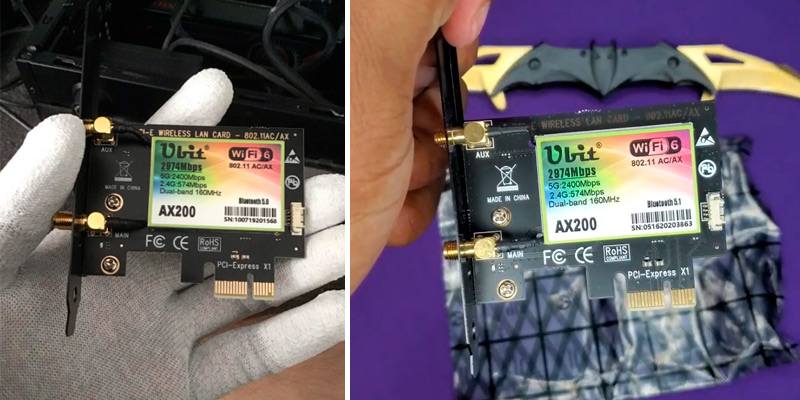
3000 Mbps
The card is fitted with the latest Bluetooth module, which is also great, despite the fact that its range is limited. What's not necessarily great is that this device comes without a heatsink. On one hand, without a heatsink, its form factor is reduced, something that we can always appreciate. On the other hand, you need to make sure that your case has sufficient cooling since the card will add heat, albeit not a lot. Now, what will add a lot is the model's 3000 Mbps throughput, covering even Google Fiber and similar connections.
In closing, as long as the case that you're using is not already suffering from excess heat, the Ubit AX200 will give you the same benefits that the most expensive PCIe wireless cards for gaming provide without carrying the price burden that these cards carry.

| Last updated price | $29.50 |
| Stock | In stock |
| ASIN | B07Y2MYK4N |

OKN AX200
Target Wake Time
The OKN AX200 is the most compact card within this lineup. Not unlike the previous model, it is also coming from an unknown brand, so while the risks are elevated, so is the reward. Paying just 30 bucks, you receive a card that offers WiFi 6, which is huge. Supporting the latest 802.11ax protocol, the card employs every WiFi 6 trick in the book, including OFDMA, 1024-QAM, and even TWT (target wake time). With the latter, you'll be able to reduce contention between multiple clients. Operating in non-overlapping times or frequencies, the same clients minimize interference, coordinating the frame exchange. This access method is especially great with battery-powered gadgets that communicate on an infrequent basis.
Of course, supporting WiFi 6, the card also covers the 160 MHz bandwidth, giving you 4 times the bandwidth capacity in dense or congested areas. Using this bandwidth, you can transfer the largest files, stream 8K movies, and manage smart home solutions without worrying that the connection might drop. That being said, while the wireless standard is practically flawless, the card is not. From time to time, it suffers from occasional signal drops. They're not even semi-frequent but, when that happens, the drops are frustrating nonetheless.
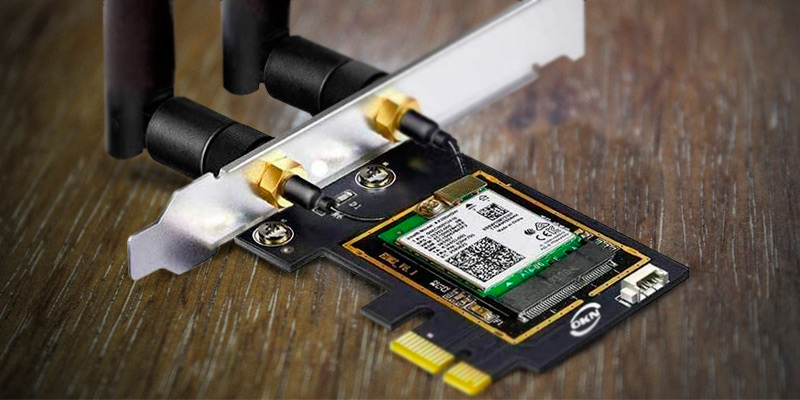
Bluetooth 5.1
Besides the methods and protocols that come with WiFi 6, the model also supports MU-MIMO. This is nothing new but the tech is an always welcome guest, improving the signal gain when multiple electronics are sending and receiving at the same time.
What is somewhat new is the Bluetooth 5.1 module that this card comes equipped with. To go with everything that Bluetooth is generally offering, the latest installment also enables Bluetooth-endowed equipment to pinpoint the connected device's location. Combining distance as well as direction, the updated protocol improves navigation indoors. With different devices, the BT module can even help you find lost keys or enable some smart home solution to pinpoint its location. But, even here, the module contributes tons, decreasing energy consumption as well as its range.
Finally, again, this is the most compact PCIe wireless card for gaming we've reviewed yet. Measuring no more than 5.12 x 3.54 x 0.79 inches, it will easily fit even the busiest, most crowded motherboards.
To conclude, the OKN AX200 will prove especially suitable for people with battery-powered devices. But everyday users will benefit from this affordable yet capable card quite alright too.
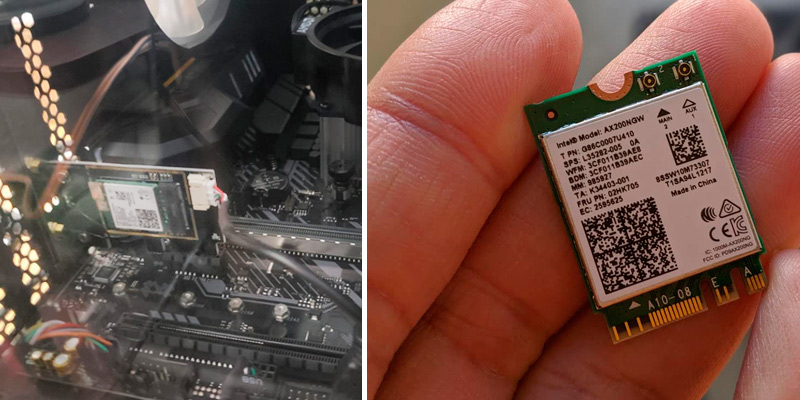
Additional Info
| Last updated price | $29.95 |
| Stock | In stock |
| ASIN | B07X462KRK |
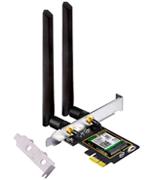
What Is a PCIe Wireless Card for Gaming?
Peripheral component interconnect express, normally abbreviated as PCIe, is an expansion bus standard, not unlike the universal series bus that even the least tech-savvy people know as USB. Two parameters separate these standards. First, PCIe is an internal bus, while USB is an external one. Second, USB is forward-compatible, while PCIe is backward-compatible. So, what this has to do with wireless cards for gaming? Well, a single USB transaction can take somewhere between 125 and 250 milliseconds. Ask gamers and they'll tell you - it is a lot. The PCIe standard, on the other hand, can complete a single transaction within 5-10 milliseconds, meaning that there's no contest between these two buses where gaming is concerned.
Putting this subject to rest, unlike routers, PCIe cards make the workspace less cluttered since you insert them inside the case, meaning that they're better for PC gaming as well. And, besides everything we've already discussed above and will discuss below, the cards that we've gathered here all support the latest security protocols, protecting you from hackers and malware via advanced encryption.
What Features to Compare
Construction
We will not be discussing contractors, circuits, the whole nine yards here. No, these complicated details do not concern an average user. What an average customer should know is whether the card comes with or without a heatsink. The cards that come with one usually ensure decent heat dissipation, with the 'sink distributing the heat away from the core components, thus lowering the device's temperature and boosting its lifespan.
The cards that do not incorporate heatsinks do not give you the same benefits. But, they're more compact. What you should figure out first is what's the average temperature inside the case and at what temperature the main hardware pieces (motherboard, GPU, and CPU) are running under different loads. As long as the cooling system suffices, you can go with a heatsink-less card. When that's not the case, we would recommend sticking with the ones that come fitted with a heatsink.
Setting aside the 'sink, some cards for desktop PCs adopt gold-plated contractors. The ones that do that prevent oxidation and protect the card from rust and corrosion, so you can even keep the case open without worrying about humidity.
Nowadays, PCIe wireless cards for gaming even employ Bluetooth modules sometimes. With a BT module, you can pair game controllers, headphones/headsets, wireless peripherals, and more.
Wireless Standards
Wireless standards, also known as wireless protocols, are tricky. Generally speaking, most WiFi-enabled devices support IEEE 802.11b/g/n/ac, somewhat answering the question. That being said, the newest routers, adapters, and PCIe cards also support IEEE 802. 11ax. Also referred to as WiFi 6, this protocol includes countless improvements, from increasing the speed to improving the communication between multiple clients. While there are no downsides to the new protocol, there are not too many devices that support it yet, so you might be futureproofing at best here.
Speed
Speed is also interesting and, at the same time, not. You look at one card capping at 1300 Mbps and the second card supporting 3000 Mbps and you figure out that the second option hands-down beats the first, right? In theory, sure. In practice, however, most households are working with ~150 Mbps so, again, you might be looking pretty far into the future when you go with a card that offers ~3000 Mbps throughput.
Extras
Every PCIe card nowadays supports the WEP/WPA/WPA2—PSK security protocols, so there's nothing to compare here. Pretty much every card comes with 2 external antennas as well. But there are cards that employ proprietary technologies (for example, ASUS with its Broadcom® TurboQAM™ and AiRadar), so make sure you take those into account as well.
PCIe Wireless Cards against USB Wireless Adapters
Users seldom choose between PCIe wireless cards or routers. No, routers are bulky, and they come with multiple wires that make the space more cluttered. People that are fine with that always go with routers since this method's disadvantages conclude with the two issues we've just outlined. But, PCIe WiFi cards versus USB WiFi adapters is a whole different contest. They're both compact solutions but, despite sharing certain similarities, they come from different angles, so let's figure out what these differences are and what are the areas where these devices outshine each other.
USB WiFi Adapters
Visually speaking, these adapters are indistinguishable from an average USB dongle. Sometimes, they come outfitted with external antennas, visually separating them from thumb drives but, more often than not, they look the same. You plug an adapter like that into one of the multiple USB ports that even the cheapest PCs incorporate these days and you're pretty much good to go. Needless to say, that is the biggest advantage of USB WiFi adapters. There's no installation at all. You don't have to remove the side cover of your case. You don't even have to turn off the computer. Just plug the device into an available USB slot and, all systems go, you're ready to browse the web. To add more, they're much more compact than PCIe cards. Like we've said earlier, these adapters are no bigger than an average USB flash drive, so they barely require any space at all. But, as you can imagine, with the small size come certain drawbacks. Even the models that come with antennas are not as powerful as PCIe cards. The reception strength is usually incomparable between the two. Furthermore, some users report that the download and upload speeds with USB adapters decrease compared to PCIe wireless cards.
PCIe WiFi Cards
We've already established what these cards are. So, what are their advantages and disadvantages? Well, to some extent, we've already revealed them above. First and foremost, PCIe cards are more powerful than USB adapters. Even more affordable cards can handle throughputs between 1300 and 3000 Mbps (there are not too many home networks that can give you that much but having the option is always nice nonetheless). Because they always come equipped with multiple antennas, the transmission range is increased as well, with an average PCIe card covering medium-sized homes with relative ease. They always provide improved signal strength and, more often than not, these cards support features like multiple-input-multiple-output spatial multiplexing (MU-MIMO). A mouthful? Sure. The gist here is that they're better at sharing the signal evenly or, when necessary, unevenly between multiple devices. Are these cards as compact as WiFi adapters? No, they're not. Is the installation part as simple, effortless, and straightforward with them? Not quite, though most cards these days are pretty easy to install as well. As a rule of thumb, PCIe cards provide a better permanent solution, while WiFi adapters present a more sound temporary fix.


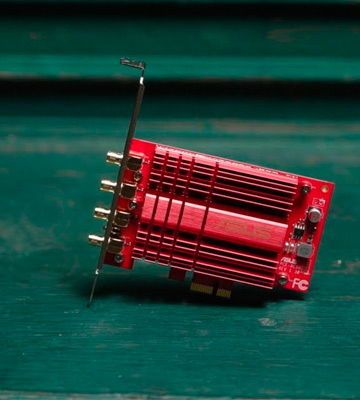

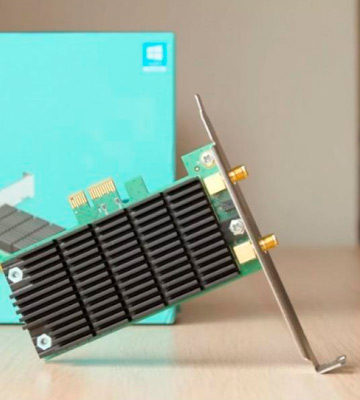
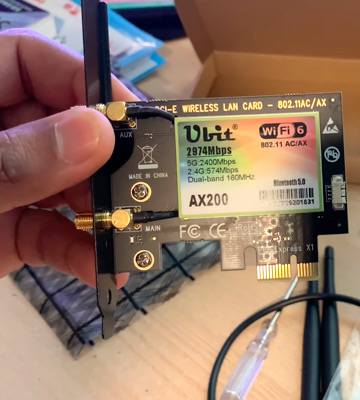


Your comment was successfully sent
Error! Please try again later